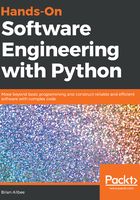
Preface
Ultimately, the purpose of this book is to illustrate pragmatic software engineering principles and how they can be applied to Python development. To that end, most of this book is dedicated to exploring and implementing what I'd consider to be a realistically scoped, but probably unrealistic project: a distributed product-management and order-fulfillment system. In many cases, the functionality is developed from scratch, and from first principles—the fundamental concepts and assumptions that lie at the foundation of the system. In a real-world scenario, the odds are good that ready-made solutions would be available to deal with many of the implementation details, but exposing the underlying theories and requirements is, I think, essential for understanding why things work the way they do. That, I believe, is an essential part of the difference between programming and software engineering, no matter what languages are in play.
Python is a rare beast in many respects—it's a dynamic language that is nevertheless strongly typed. It's an object-oriented language too. These, taken together, make for an amazingly flexible and sometimes surprisingly powerful language. Though it can be taken as my opinion, I strongly believe that you'd be hard-pressed to find another language that is as generally capable as Python that is also as easy to write and maintain code in. It doesn't surprise me in the least that Python has racked up the kinds of success stories that are listed on the language's official site (https://www.python.org/about/success/). It also doesn't surprise me that Python is one of the core supported languages for at least two of the big name public cloud providers—Amazon and Google. Even so, it's often still thought of as only a scripting language, and I sincerely hope that this book can also show that view to be wrong.